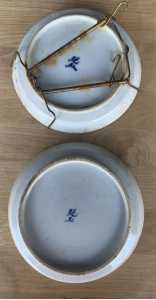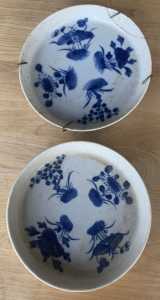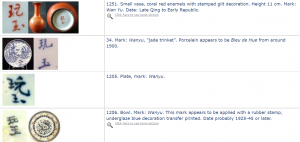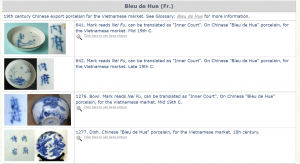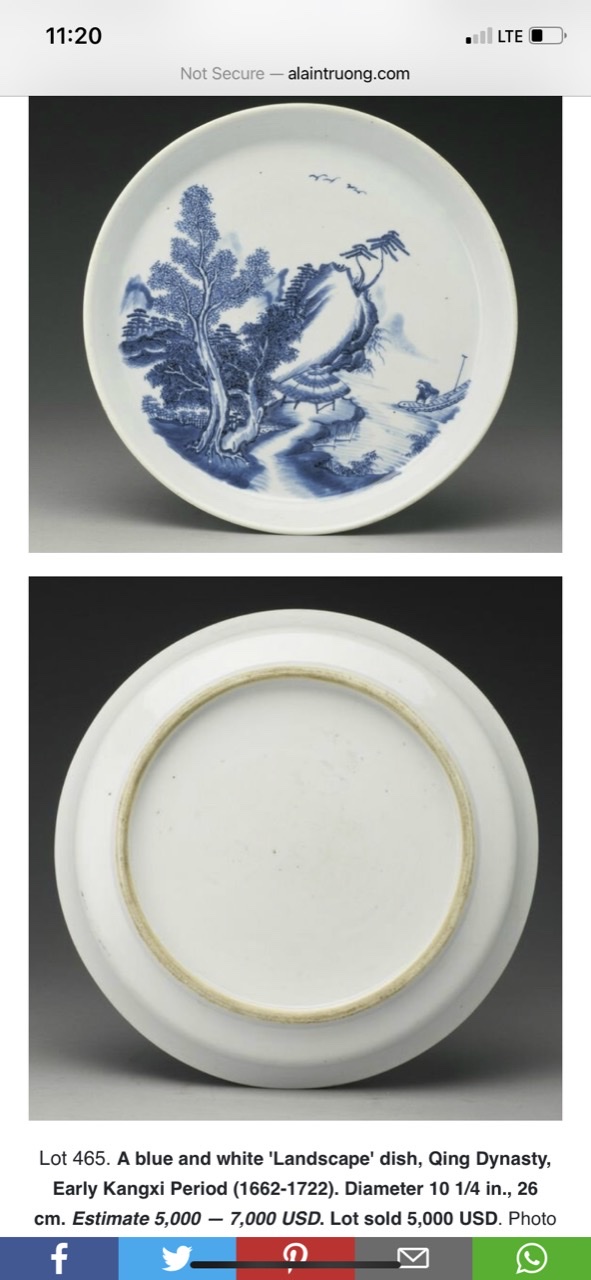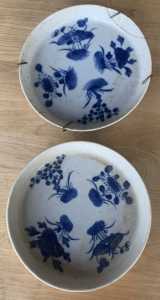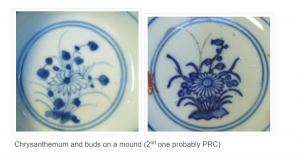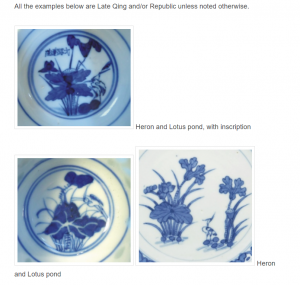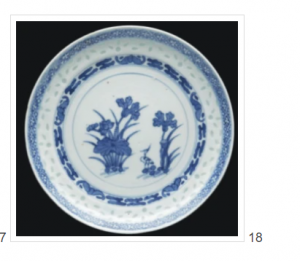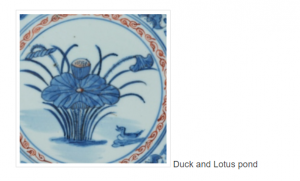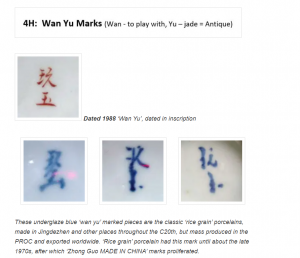The Chinese and Asian Art Forum. For Fans, Collectors and Dealers.
 Basic Rules For the BidAmount Asian Art Forum: Talk about whatever you want. You can even discuss and offer things that are for sale if they are authentic. Maximum image file size per post is 2 MB. Images of 700pxl x 700pxl are optimal if saved at a medium resolution. Be respectful of others and enjoy yourself. Click the YouTube link for a brief tutorial on using the forum. You can also EMBED Videos by cutting and pasting from You-Tube, Vimeo etc.
Basic Rules For the BidAmount Asian Art Forum: Talk about whatever you want. You can even discuss and offer things that are for sale if they are authentic. Maximum image file size per post is 2 MB. Images of 700pxl x 700pxl are optimal if saved at a medium resolution. Be respectful of others and enjoy yourself. Click the YouTube link for a brief tutorial on using the forum. You can also EMBED Videos by cutting and pasting from You-Tube, Vimeo etc.
NOTE: To post an item or add a new post, click open the category title from the FORUM LIST, and CLICK the Blue ADD TOPIC button.
These could be 19th century Bleu de Hue for the Vietnamese market.
Birgit
Birgit is right.
Wanyu appears on Chinese porcelain from the Kangxi period and onwards. The mark shows the characters for (top) plaything/to play and (bottom) jade. The meaning is rather abstract but can perhaps be translated as "jade trinket" or "antique porcelain as fine as jade". The mark first appeared in Kangxi but has been used well into the 20th century.
It is also one of the marks used on later Bleu de Hue porcelain for the Vietnamese market
I'd say they were both 19th c, too. Pretty dishes; shame about the damage.
@short-dong So if the same dish hit the market through Hong Kong it would be Chinese but if it came from Vietnam it would bleu de hue Chinese, I'm not sure how that distinction can be made if you do not know where it was acquired? Is it the style? Did it all go to Vietnam?
@short-dong So if the same dish hit the market through Hong Kong it would be Chinese but if it came from Vietnam it would bleu de hue Chinese, I'm not sure how that distinction can be made if you do not know where it was acquired? Is it the style? Did it all go to Vietnam?
That is all way above my paygrade, I just instantly recognised the backmark which is common to rice bowls and the like, and knew it was also found on modern ware. I just knew where to find it quickly to help with the assessment.
I suppose blue de hue is no different than using the term Kitchen Qing. I mean this is more a Frankurt School of critical theory argument and overly rigid categorisations, and I am not really that knowledgable on the underlying methodological approach behind these terms i.e Kitchen Qing and or Hue de bleu. I think Kitchen Qing was a term adopted by 'every day' maylasian people. What organisation or whom agrees the ultimate dialectic determination is beyond me. Kitchen Qing is not as valuable and in my opinion as was the case in Japan where western exports were of a higher quality than exports to dare i say provinical neighbouring countries. As the west has the moola.
As to wether they are Kangxi, on one hand they appear to be a set, one plate does appear to have a different shape, but they have similar backmarks and similar design and similar sizes and possibly shapes. On the balance of probabilities they came from the same era. If one is 19th century than more than likley so is the other. However maybe a fisherman in Vietnam had one of those plates and saw a similar one in the market and decided to make a set, and the second one happened to be Kangxi. Then they were sold to tourist, or vice versa. They got sold as a set thrown togther.
However, based on the distinct nature of the backmark they are more likely chinese Wanyu circa late 19th early 20th century, and as Chinese are less likely to be Kangxi unless they are blue de hue. Yes, there is a chance they are Kangxi, but how can you prove it.
I should provide a link, but really that is all the information it has, other than to get a better look at some of the pictures.
https://www.gotheborg.com/marks/20thcenturychina.shtml
@short-dong Thank you, no further questions, I tender the witness. Good job and I always appreciate references and pictures. Sharon
I did not purchase due to the one being damaged but am interested in learning more about this topic. My understanding is late 19th century pieces are garnished in metal to protect from chipping.
@lotusblack It is a design common to rice bowls and it is hard to find a 19th centiry rice bowl and almost as hard to find a republican rice bowl. They are usually PROC.
Your plates
Here are some examples...
Your back mark and the design are the reason why I think they are connected. If the bowls are as suggested to be 19th Century then tyhey are at the very least rare in the world of rice bowls if that makes any sense.
@short-dong it does make sense. I thank you for you research in this area. One Of the things that amazes me everyday is the different varieties of asian porcelain. I also believe we will never ever see all that has been created. These are study pieces as for many others. I have seen members getting desensitized but we must continue to force ourselves to learn about any piece even if we don’t recognize it. One of the things I like about not being experienced is by bring pieces that I don’t understand gives everyone else the opportunity to learn about all types and styles. I don’t believe in the phase junk items as they help us learn about great items. I have learned just as much from holding modern as I have from holding antique it all helps tell the story of Asian art.
@lotusblack Thanks Brian, Yes I agree, but it is a big threshold. Somtimes I prefer something simple like Nippon or famille rose and venture no further. That is not to say i am not eager to learn and just read a brilliant post about Chongzeng/Shunzi Design and painting style from Ronm and Ming1449 in the Ming box topic. It does inspire and motivate me to learn more. Over the past 500 years, there is a huge array of peices that need to be fit together and if rice bowls helps with that then all the better.
@short-dong I picked up 2 famille rose plaques today. So you might be in for another treat if they are authentic of course.
Thanks for visiting "The BidAmount Asian Art Forum | Chinese Art"
If you sell on eBay, or have a shop feel free to post images and descriptions and links.
Check back often for discussion about the latest news in the Chinese art and antique world. Also find out about the latest Asian art auctions at Sotheby's, Christie's, Bonhams and Tajans.
Auction results for: fine porcelain, ceramics, bronze, jade, textiles and scholar's objects. As well as Japanese, Thai, Vietnamese and other Asian cultures.
Thank you,
Peter Combs
Topics and categories on The BidAmount Asian Art Forum | Chinese Art
Kangxi vases, Kangxi dishes and chargers, Kangxi ritual pieces, Kangxi scholar's objects, Qianlong famille rose, Qianlong enamels, Qianlong period paintings, Qianlong Emporer's court, Fine porcelain of the Yongzheng period. Chinese imperial art, Ming porcelain including Jiajing, Wanli, Xuande, Chenghua as well as Ming jades and bronzes.
The BidAmount Asian Art Forum | Chinese Art
A free Asian art discussion board and Asian art message board for dealers and collectors of art and antiques from China, Japan, Korea, Thailand, Cambodia, Vietnam and the rest of Asia. Linked to all of the BidAmount Asian art reference areas, with videos from plcombs Asian Art and Bidamount on YouTube. Sign up also for the weekly BidAmount newsletter and catalogs of active eBay listing of Chinese porcelain, bronze, jades, robes, and paintings.
The art of calligraphy - and for the ancient Chinese it certainly was an art - aimed to demonstrate superior control and skill using brush and ink. Calligraphy established itself as one of the major Chinese art forms during the Han dynasty (206 BCE - 220 CE), and for two millennia after, all educated men were expected to be proficient at it.
The Museum’s collections of Asian art span nearly five millennia and encompass the cultures of China, the Himalayas, India, Japan, Korea, and Southeast Asia. In 2007, the Museum launched an initiative to create dedicated galleries for the collection, beginning with a gallery for the arts of Korea ...
Chinese art is full of symbolism, in that artists typically seek to depict some aspect of a totality of which they are intuitively aware.
China Online Museum is the finest online museum of Chinese art. It features Chinese calligraphy, painting, ceramics, bronzes, carving, and other artworks.
Chinese Ceramics & Works of Art. Overview Upcoming auctions Contacts Auction results ... Christie’s sales of Chinese ceramics and works of art showcase centuries of Chinese history. Held throughout the year in London, New York, Paris and Hong Kong, they attract a wide audience of collectors and connoisseurs vying for pieces as diverse as ...
Explore Asian Art Week. Contact the Specialist Department. Chinese Paintings ... Senior Specialist, Head of Sale. [email protected]. Tel:+1 212 641 5760. Bid in-person or online for the upcoming auction:Fine Chinese Paintings on 10 September 2019 at New York. Bid in-person or online for the upcoming auction:Fine Chinese Paintings on 10 ...
Discover an abundance of must-see art from all corners of a vast continent at Christie’s NY Asian Art Week. From contemporary classical and Chinese paintings to works with exemplary provenance from the Art Institute of Chicago, our Rockefeller Paza galleries will be full of ancient treasures and contemporary masterworks in a salute to the vibrant arts of Asia.
Sold to benefit The Art Institute of Chicago’s Asian Art Acquisition Fund, the sale features 84 lots with a focus on Ming and Qing porcelains, and offers a rare insight into the taste for collecting Chinese ceramics and works of art in the Midwest from the end of the 19th century through the 1980s. Highlights include two Wanli wucai garlic-head vases, a Qianlong mark and period, blue and ...
Specialist, Chinese Paintings, Christie's London Dr Malcolm McNeill is a Specialist in Chinese Paintings at Christie’s, based in London. He previously worked as an assistant curator of the Chinese collections and the Victoria and Albert Museum in London, as a researcher at the British Museum, and as a translator and tour guide at the National Palace Museum in Taipei.
The Christie's Education 2020 Conference: The Chinese Art Market 18 Jun 2019 Christie’s Education is delighted to announce our first international academic conference in Asia which will take place in Hong Kong from 26-27 November 2020 at the Hong Kong Convention and Exhibition Centre and will run in parallel with Christie’s Hong Kong Autumn Auctions.
The summer Chinese Art sale in Hong Kong will feature works of art from several private collections, including Qing porcelains and textile from the collection of the legendary Chinese art dealer A. W. Bahr (1877–1959), fine gilt bronze Buddhist sculptures from an old Hong Kong collection, an East Asian collection of Qing dynasty wine cups and jades, and a Japanese collection of Song ceramics ...
Sotheby's Chinese Works of Art Department holds two auctions each year in London, New York, Hong Kong and Paris.
Chinese Art - View Auction details, bid, buy and collect the various artworks at Sothebys Art Auction House.
With more than 340 Chinese works of art dating from the Neolithic to the Republic periods, highlights of this sale include a selection of Qing Imperial monochromes from the collection of Arnold and Blema Steinberg, early ceramics from the Art Institute of Chicago and Chinese porcelain and works of art from the collection of Henry Arnhold.
Results: Sotheby's Asia Week achieved $52.4 million in six strong auctions, exceeding pre-sale estimates. With 76.5% of lots sold and 60.3% of lots surpassing high estimates, the Asian art sales at Sotheby's indicate continued collector interest in the finest works of art from China, India and and the Himalayas.
Today's sale of Important Chinese Art will proceed as planned with sessions at 10 AM and 2 PM EDT. Sotheby's will be monitoring the weather conditions throughout the day and will be available to coordinate alternative bidding options should conditions make it difficult for clients to attend the auction in person.
Bonhams Chinese Art department is renowned for offering the finest works of art representing the richness and breadth of China's artistic heritage, particularly Imperial porcelain, white and spinach green jades, cloisonné and Buddhist art. Specialised international auctions are held globally, including London, Hong Kong and San Francisco.
Bonhams : Chinese Works of Art We use cookies to remember choices you make on functionality and personal features to enhance your experience to our site. By continuing to use our site you consent to the use of cookies. Please refer to our privacy and cookie policies for more information.
Bonhams Fine Art Auctioneers & Valuers: auctioneers of art, pictures, collectables and motor cars. We use cookies to remember choices you make on functionality and personal features to enhance your experience to our site. By continuing to use our site you consent to the use of cookies. ... Chinese Art (US) General enquiries
Bonhams : Fine Chinese Art We use cookies to remember choices you make on functionality and personal features to enhance your experience to our site. By continuing to use our site you consent to the use of cookies. Please refer to our privacy and cookie policies for more information.
Bonhams Fine Art Auctioneers & Valuers: auctioneers of art, pictures, collectables and motor cars Bonhams : Asian Art We use cookies to remember choices you make on functionality and personal features to enhance your experience to our site.
Bonhams are international auctioneers of fine Chinese and Japanese art. We specialise in rare Imperial and Export Chinese ceramics and works of art, as well as Japanese ceramics, fine and decorative works of art from the Neolithic Period to the 20th century. View on map
Bonhams Fine Art Auctioneers & Valuers: auctioneers of art, pictures, collectables and motor cars. We use cookies to remember choices you make on functionality and personal features to enhance your experience to our site. By continuing to use our site you consent to the use of cookies. ... Asian Art Bonhams. Work. 22 Queen St.
